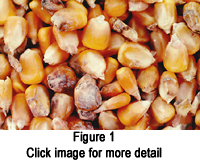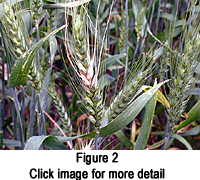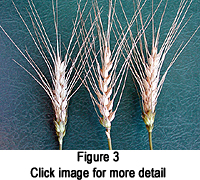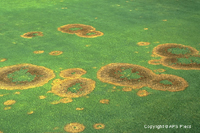Marie A. C. Langham
South Dakota State University
 |
|
In 1990-1991 along the Texas-Mexico border, a sudden increase in the births of children with neural tube defects occurred. Neural tube defects, which include anencephaly and spina bifida, occur during the embryonic development when the neural tube fails to close. In a recent study (2), women who lived in one of fourteen counties along the Texas-Mexican border and gave birth during 1995-2000 were divided into research groups based on whether or not their child had a neural tube defect at birth. Information about the mother’s consumption of corn tortillas was collected, and consumption of 300 or more tortillas during the first trimester of pregnancy significantly increased the odds of the baby having a neural tube defect. Consumption of tortillas was a concern, because mycotoxins called fumonisins (produced by Fusarium verticilloides Figs 1) were thought to be present in the corn flour from which the tortillas were made. Fumonisins block activity of the enzyme ceramide synthase, and cause a buildup of sphinganine (1). Why is ceramide synthase important? Ceramide functions in the transport and utilization of folic acid (Vitamin B9), an important factor in neural tube development. Thus, fumonisins block the body’s ability to utilize folic acid.
|
 |
What are mycotoxins? Are fumonisins the only mycotoxins of concern to humans and animals? Are other mycotoxins dangerous? Mycotoxins are nonvolatile, low-molecular weight compounds that are produced as secondary metabolites (by-products) during fungal growth. They are not required for fungal growth, but they may function in inhibiting other competitive microorganisms. Several species of fungi are known to produce mycotoxins. These include Alternaria, Aspergillus, Claviceps, Fusarium, Penicillium, Myrothecium, Stachybotrys, and Trichoderma. One of the most widely known mycotoxins is aflatoxin, produced by Aspergillus flavus. Aflatoxin has been a problem in stored grains, such as corn, and in peanuts for many years. Aflatoxin has been indicated to be carcinogenic, damaging to the liver, and immunosuppressive. In addition to fumonisins, the fungal genus Fusarium produces many other mycotoxins. One of these, deoxynivalenol (DON), is produced by F. graminearum, the causal agent of stalk and ear rot in corn and head blight or scab in wheat and barley (Figs 2 and 3)." . This toxin causes feed refusal in animals, vomiting, hemorrhage and necrosis of the digestive tract, immunosuppression, decreased blood production, and birth defects. Other mycotoxins have similar effects on animals and humans. Historically, mycotoxins, such as those produced by Claviceps purpurea, have only become known when widespread epidemics of mycotoxicosis (mycotoxin poisoning) have occurred. Today, milling and other food quality standards define the maximum amount of mycotoxins allowed in foods. Thus, mycotoxin identification and quantification are important issues in many foods, and mycotoxins link plant disease with human and animal health.
 |
Literature Cited
- Marasas, W. F. O., Riley, R. T., Hendricks, K. A., Stevens, V. L., Sadler, T. W. , Gelineau-van Waes, J., Missmer, S. A., Cabrea, J., Torres, O., Gelderblom, W. C. A., Allegood, J., Martinez, C., Maddox, J., Miller, J. D., Starr, L., Sullards, M. C., Roman, A. V., Voss, K. A., Wang, E. and Merrill, A. H. 2003. Fumonisins disrupt sphingolipid metabolism, folate transport, and neural tube development in embryo culture and in vivo: A potential risk factor for human neural tube defects among populations consuming fumonisins-contaminated maize. Journal of Nutrition 134:711-716.
- Missmer, S. A., Suarez, L., Felkner, M., Wang, E., Merrill, A. H., Rothman, K. J., and Hendricks, K. A. 2004.Exposure to fumonisins and the occurrence of neural tube defects along the Texas-Mexico border. Environmental Health Perspectives 114:237-241.
Suggested Activities
AP Biology, Biology, or Health Sciences
- Construct a model of the pathway for folic acid transport and utilization (See Literature Cited #1)
- Compile a chart of mycotoxins and their effects
- Do a demographic survey to compare brand preference (name brands vs. generic brands) and determine the consumption of a food product, such as peanut butter, that has regulated limits for known mycotoxins
Middle or Junior High School
- Track the foods consumed and the amounts consumed by classes in a week or a month
- Research how food products, such as grains, are stored during the trail of shipment and sale
- Determine the standards that commonly used food items, such as flour, have to meet for sale in the US
Elementary
- Track how much of a common food, such as bread or peanut butter is consumed in a week
- Research what are fungi and how they affect plants
- Project what might happen if a common food was unavailable due to crop failure or contamination
|
 |
Views: With spring’s return, lawn care will once again be a weekly chore for homeowners and the daily concern for many turf managers. Proper lawn care is the first step in controlling diseases, such as Southern blight. Irrigation and fertilization should be applied as recommended for your grass species. Thatch management is another important cultural control of many turf diseases. Click image for an enlarged view and more information.
|
